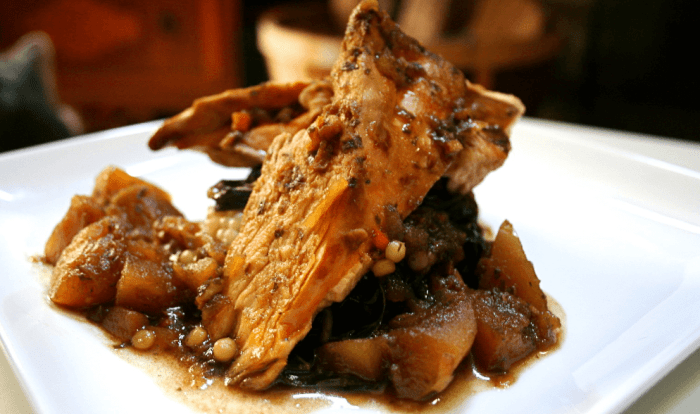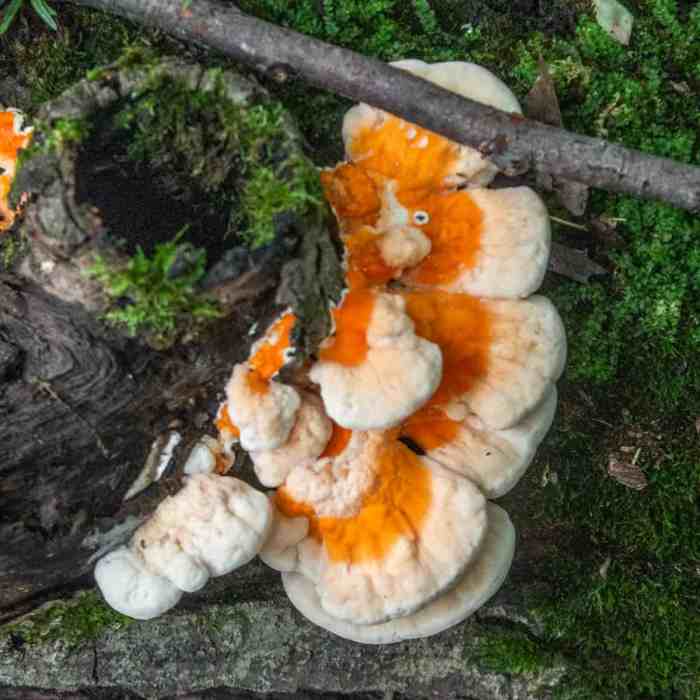
Prepare to tantalize your taste buds and nourish your body with our exploration of the delectable chicken of the woods recipe. This wild mushroom boasts a remarkable culinary versatility and an array of health-promoting properties, making it a true gem in the world of gastronomy and wellness.
From identifying and harvesting these mushrooms safely to showcasing innovative culinary presentations, this comprehensive guide will empower you to fully embrace the culinary and nutritional wonders of chicken of the woods.
Chicken of the Woods Identification and Preparation

Chicken of the woods (Laetiporus sulphureus) is a large, bright orange mushroom that grows on the trunks of oak and other hardwood trees. It is a popular edible mushroom that has a meaty texture and a slightly sweet flavor.
Chicken of the woods is easy to identify by its bright orange color and its shelf-like shape. The mushrooms can be quite large, and they often grow in clusters. The flesh of the mushroom is white and firm, and it has a slightly sweet flavor.
Chicken of the woods is a safe mushroom to eat, but it is important to cook it thoroughly before eating it. Raw chicken of the woods can cause stomach upset.
Culinary Applications of Chicken of the Woods

Chicken of the woods is a versatile culinary mushroom that offers a meaty texture and savory flavor. Its culinary applications are diverse, ranging from soups and stews to stir-fries and roasts.
The key to cooking chicken of the woods is to remove any tough or woody parts. Once cleaned, the mushroom can be cooked in a variety of ways. Here are some popular culinary applications:
Soups and Stews
- Chicken of the woods adds a meaty depth to soups and stews. Its flavor pairs well with root vegetables, such as carrots and potatoes, and herbs, such as thyme and rosemary.
- To use chicken of the woods in soups and stews, sauté it in a little butter or oil until browned. Then, add it to the soup or stew and simmer until tender.
Stir-Fries
- Chicken of the woods is a great addition to stir-fries. Its meaty texture holds up well to the high heat of a stir-fry.
- To use chicken of the woods in stir-fries, cut it into bite-sized pieces and sauté it in a little oil until browned. Then, add it to the stir-fry and cook until tender.
Roasts
- Chicken of the woods can be roasted in the oven for a flavorful and hearty dish.
- To roast chicken of the woods, toss it with olive oil, salt, and pepper. Then, roast it in a preheated oven at 400 degrees Fahrenheit for 20-25 minutes, or until tender.
Pairing Suggestions
Chicken of the woods pairs well with a variety of ingredients and seasonings. Some popular pairings include:
- Root vegetables, such as carrots, potatoes, and parsnips
- Herbs, such as thyme, rosemary, and sage
- Garlic and onions
- Soy sauce and sesame oil
- White wine and chicken broth
With its versatility and delicious flavor, chicken of the woods is a great addition to any kitchen. Experiment with different cooking methods and pairings to find your favorite way to enjoy this unique mushroom.
Looking for a delicious and unique way to enjoy mushrooms? Check out this chicken of the woods recipe . This edible fungus has a meaty texture and a slightly nutty flavor, making it a great substitute for chicken in many dishes.
Whether you’re grilling, sautéing, or roasting, this recipe will help you create a flavorful and satisfying meal.
Nutritional Value and Health Benefits

Chicken of the woods mushrooms are a rich source of various nutrients, including vitamins, minerals, and antioxidants. They are particularly high in fiber, potassium, vitamin C, and vitamin D. Fiber helps to promote a healthy digestive system, while potassium supports heart health.
Vitamin C is an important antioxidant that helps protect the body against damage from free radicals, and vitamin D is essential for bone health.
Antioxidant and Anti-inflammatory Properties, Chicken of the woods recipe
Chicken of the woods mushrooms contain several antioxidants, including ergothioneine and phenolic compounds. These antioxidants help to protect the body against oxidative stress, which is caused by free radicals. Free radicals are unstable molecules that can damage cells and DNA, leading to inflammation and chronic diseases such as cancer and heart disease.
Chicken of the woods mushrooms also contain anti-inflammatory compounds that may help to reduce inflammation throughout the body.
If you’re new to cooking with chicken of the woods, don’t worry! This chicken of the woods recipe is easy to follow and provides clear instructions for every step. You’ll learn how to clean and prepare the mushrooms, as well as how to cook them to perfection.
So grab some chicken of the woods and get ready to enjoy a delicious and healthy meal.
Contraindications and Precautions
Chicken of the woods mushrooms are generally considered safe to eat, but there are a few potential contraindications and precautions to consider. Some people may experience allergic reactions to chicken of the woods mushrooms, especially if they are allergic to other types of mushrooms.
Additionally, people with weakened immune systems should avoid eating raw chicken of the woods mushrooms, as they may be more susceptible to foodborne illnesses. It is always best to cook chicken of the woods mushrooms thoroughly before eating them.
Cultivation and Foraging of Chicken of the Woods

Chicken of the woods mushrooms are found in various forests worldwide. They prefer to grow on dead or dying hardwood trees, particularly oak, maple, and beech. These mushrooms typically appear in late summer to early fall, forming large, shelf-like structures on the sides of trees.
Natural Habitat and Growing Conditions
Chicken of the woods mushrooms thrive in moist, shady environments with ample decaying wood. They require a specific balance of temperature and humidity to fruit successfully. The ideal temperature range for growth is between 50-70°F (10-21°C), with higher humidity levels promoting larger and more robust mushrooms.
Foraging for Chicken of the Woods Mushrooms
When foraging for chicken of the woods mushrooms, it’s crucial to identify them accurately to avoid potentially toxic lookalikes. Look for the characteristic bright orange or yellow color, large size, and shelf-like shape. Avoid harvesting mushrooms that are old, slimy, or show signs of insect damage.
Cultivating Chicken of the Woods Mushrooms
Chicken of the woods mushrooms can be cultivated at home or on a commercial scale. The process involves inoculating logs or sawdust with mushroom spawn and providing suitable growing conditions. Maintaining optimal temperature, humidity, and air circulation is essential for successful cultivation.
Commercial cultivation often uses controlled environments to ensure consistent production.
Creative Culinary Presentations: Chicken Of The Woods Recipe
Chicken of the woods offers a unique opportunity for culinary creativity. Its versatile texture and flavor profile lend themselves to a wide range of innovative presentations that will tantalize the senses and impress guests.
When plating chicken of the woods dishes, consider using contrasting colors and textures to create visual appeal. For example, pair the golden-orange hue of the mushroom with crisp greens, such as arugula or watercress, or offset its firm texture with soft, creamy elements like polenta or goat cheese.
Garnishes
- Fresh herbs, such as thyme, oregano, or parsley, add a pop of color and freshness.
- Edible flowers, such as nasturtiums or pansies, provide a delicate touch of beauty and flavor.
- Roasted nuts, such as almonds or hazelnuts, add a crunchy texture and nutty flavor.
Plating Techniques
- Create a layered presentation by alternating slices of chicken of the woods with other ingredients, such as roasted vegetables or grilled halloumi.
- Use a ring mold to shape the chicken of the woods into a cylindrical tower, then fill the center with a creamy sauce or mousse.
- Arrange the chicken of the woods on a bed of greens and drizzle with a vibrant vinaigrette.
Table Settings
- Choose rustic tableware, such as wooden bowls or stone plates, to complement the earthy nature of the mushroom.
- Set the table with warm, inviting colors, such as orange or yellow, to create a cozy atmosphere.
- Use natural elements, such as twigs or moss, as table decorations to enhance the forest-like ambiance.
Molecular Gastronomy and Fusion Cuisine
Chicken of the woods can also be incorporated into molecular gastronomy and fusion cuisine to create dishes that are both innovative and delicious.
- Use spherification techniques to create chicken of the woods caviar, which can be served as a garnish or as part of a larger dish.
- Experiment with different cooking methods, such as sous vide or pressure cooking, to achieve unique textures and flavors.
- Combine chicken of the woods with unexpected ingredients, such as Asian spices or tropical fruits, to create fusion dishes that tantalize the palate.
Closing Notes

Whether you’re a seasoned forager, a culinary enthusiast, or simply seeking to expand your culinary horizons, the chicken of the woods recipe offers a captivating journey of flavors and nourishment. Embrace the opportunity to experience this extraordinary mushroom and unlock its culinary and health-promoting potential.
Common Queries
Can I eat chicken of the woods raw?
No, it’s not recommended to consume chicken of the woods raw as it may cause digestive issues.
How do I store chicken of the woods?
Store fresh chicken of the woods in the refrigerator for up to 5 days or in the freezer for up to 6 months.
Is chicken of the woods safe for pregnant women?
Yes, chicken of the woods is generally considered safe for pregnant women to consume in moderation.